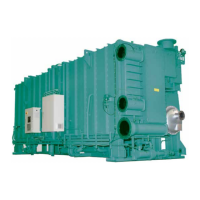JOHNSON CONTROLS
167
FORM 155.31-ICOM2.EN.UL
ISSUE DATE: 12/21/2018
9
SECTION 9 - DECOMMISSIONING, DISMANTLING, AND DISPOSAL
Unless otherwise indicated, the operations described
below can be performed by any properly trained main-
tenance technician.
1. Isolate all sources of electrical supply to the unit,
including any control system supplies switched
by the unit. Make sure that all points of isolation
are secured in the OFF position.
2. Disconnect and remove the supply cables. For
connection points, see SECTION 3 – HANDLING,
STORAGE, INSTALLATION AND REASSEM-
BLY.
3. Fill the interior of the unit with N2 gas to pressur-
ize up to 1.5~3 PSIG.
4. Prepare a suitable container. See Table 13 on page
46 and Table 9 on page 40.
5. Drain the remainder of the solution and refriger-
ant in the unit from each service valve as com-
pletely as possible into the container.
6. Dispose of the refrigerant and solution in a suit-
able and safe manner.
7. Isolate the unit heat exchanger from the external
water systems. Drain the heat exchanger section
of the system. If no isolation valves are installed
it may be necessary to drain the complete system.
8. If glycol was used in the water system, or chemi-
cal additives are contained, dispose of the solution
in a suitable and safe manner. After draining, dis-
connect and remove the water.
Under NO circumstances should any
system containing glycol be drained
directly into domestic waste or natural
water systems.
9. Remove xing down bolts. Lift the unit from po-
sition, using the points provided and equipment
with adequate lifting capacity.
See SECTION 3 – HANDLING, STORAGE, INSTAL-
LATION AND REASSEMBLY for unit installation in-
structions, and Table 13 on page 46 and Table 9 on
page 40 for unit weights.
Units which cannot be removed in one piece after dis-
connection, must be dismantled in position. Handle
each component carefully. Where possible, dismantle
units in the reverse order of installation.
Make sure that while components are being removed,
the remaining parts are supported in a safe manner.
Only use lifting equipment of adequate
capacity.
After removing the unit from position, dispose of the
unit parts according to local laws and regulations.

